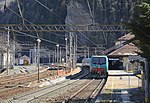Fréjus Road Tunnel

The Fréjus Road Tunnel is a tunnel that connects France and Italy. It runs under Col du Fréjus in the Cottian Alps between Modane in France and Bardonecchia in Italy. It is one of the major trans-Alpine transport routes between France and Italy being used for 80% of the commercial road traffic. Construction of the 13 km (8.1 mi) long tunnel started in 1974, and it came into service on 12 July 1980, leading to the closure of the motorail shuttle service in the Fréjus rail tunnel. It cost 2 billion francs (equivalent to €700 million at 2005 prices). It is the thirteenth longest road tunnel in the world. The French section is managed by the French company SFTRF, and the Italian section by the Italian company SITAF. (The French politician Pierre Dumas was chairman of SFTRF from 1962 to 1989). The tunnel can be reached from the Italian side by the A32 Torino-Bardonecchia motorway, or by SS335 from Oulx, which joins SS24 (“del Monginevro”), and reaches Bardonecchia after 20 km (12 mi). From the French side, it can be reached by the A43 (“l’Autoroute de la Maurienne”) from Lyon and Chambéry. A toll is charged to all traffic. Over 20 million vehicles passed through the tunnel during the first 20 years.
Excerpt from the Wikipedia article Fréjus Road Tunnel (License: CC BY-SA 3.0, Authors, Images).Fréjus Road Tunnel
Fréjus Road Tunnel, Saint-Jean-de-Maurienne
Geographical coordinates (GPS) Address External links Nearby Places Show on map
Geographical coordinates (GPS)
| Latitude | Longitude |
|---|---|
| N 45.140833333333 ° | E 6.6888888888889 ° |
Address
Tunnel du Fréjus
Fréjus Road Tunnel
73500 Saint-Jean-de-Maurienne
Auvergne-Rhône-Alpes, France
Open on Google Maps









